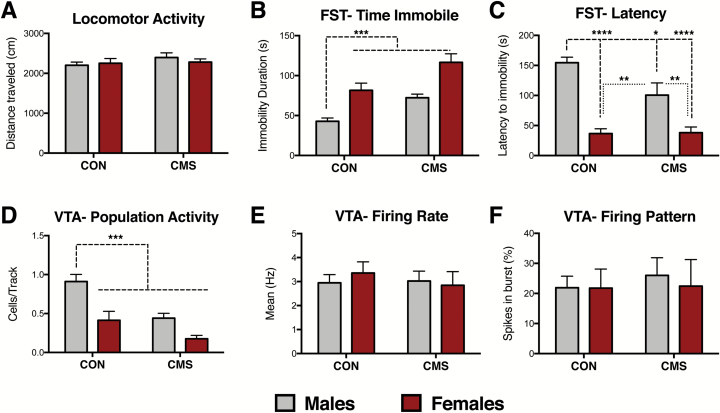Figure 4.
Female rats exhibited greater behavioral and ventral tegmental area (VTA) dopamine (DA) neuron activity responses post-forced swim test (FST). (A) No effects of sex (P= .75) or chronic mild stress (CMS) (P= .27) were found for locomotor activity (CON groups: n = 12, CMS groups: n = 11). (B) Females exhibit higher immobility duration than males in the FST; CMS exposure increases immobility in the FST (CON groups: n = 12, CMS groups: n = 11; significant effects of both sex [P< .001] and CMS [P< .001]). (C) Females exhibit reduced latency to immobility compared with males in the FST; CMS reduces latency to immobility [(CON groups: n=12, CMS groups: n=11; significant effects of both sex (P< .0001) and CMS (P< .05) and an interaction between sex and CMS (P< .05)]. (D) Post-FST, females exhibited lower numbers of spontaneously active VTA DA neurons (i.e., cells per track) compared with males, consistent with a sex difference in response to swim stress. CMS reduced the number of spontaneously active DA neurons post-FST. CMS males and females exhibited reduced cells/track compared with CON males (significant effects of sex [P< .001] and CMS [P< .001] on spontaneous VTA DA neuron activity (CON groups: n = 6, CMS males: n = 7, CMS females: n = 5). Notably, these recordings were done in animals that underwent the FST. (E) No effects of sex (P= .82) or CMS (P= .67) were found for firing rate. (F) No effects of sex (P= .78) or CMS (P= .71) on percent of neurons firing in burst. Error bars represent mean ± SEM. Gray bars represent males; red bars represent females. *P< .05, **P< .01, ***P< .001, ****P< .0001.

